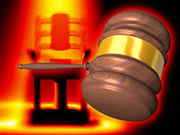|
|
|
Death sentences at lowest level in 30 years
Law Center |
2007/01/05 20:15
|
| The number of death sentences issued in 2006 reached the lowest level in 30 years, according to a 2006 year-end report issued by the Death Penalty Information Center. The DPIC reported that there were at most 114 death sentences issued in 2006, as opposed to 128 in 2005 and the 1996 high of 317. In addition, only 53 executions were carried out, as opposed to the 60 performed in 2005. Deborah Fleischaker, director of the American Bar Association's Death Penalty Moratorium Implementation Project, cited a lack of public confidence in the death penalty as a result of the possibility of making mistakes, illuminated by the release of 123 people from questionable death row sentences since 1976. A total of 53 executions were carried out in 2006, down from 60 in 2005. Executions over the past three decades peaked at 98 in 1999. Among the many causes given by prosecutors, lawyers and death penalty critics: the passage of more state laws that allow juries to impose life without parole; an overall drop in violent crime; and a reluctance among some authorities to pursue the death penalty because of the high costs of prosecuting a capital case. On Tuesday, a New Jersey State commission recommended that the state abolish the death penalty completely, replacing it with a life sentence without the possibility of parole. If the commission's report makes its way into law New Jersey will become the first US jurisdiction to ban capital punishment in over 35 years. In December, Florida Governor Jeb Bush suspended all executions in that state after a lethal injection execution there was botched, and a federal judge in California effectively suspended capital punishment there by ruling that that state's lethal injection procedure creates "an undue and unnecessary risk" of cruel and unusual punishment in violation of the Eighth Amendment of the US Constitution. |
|
|
|
|
|
|
Class action or a representative action is a form of lawsuit in which a large group of people collectively bring a claim to court and/or in which a class of defendants is being sued. This form of collective lawsuit originated in the United States and is still predominantly a U.S. phenomenon, at least the U.S. variant of it. In the United States federal courts, class actions are governed by Federal Rules of Civil Procedure Rule. Since 1938, many states have adopted rules similar to the FRCP. However, some states like California have civil procedure systems which deviate significantly from the federal rules; the California Codes provide for four separate types of class actions. As a result, there are two separate treatises devoted solely to the complex topic of California class actions. Some states, such as Virginia, do not provide for any class actions, while others, such as New York, limit the types of claims that may be brought as class actions. They can construct your law firm a brand new website and help you redesign your existing law firm site to secure your place in the internet. |
Law Firm Directory
|
|





